Morris & Fan. Reservoir Sedimentation Handbook
Подождите немного. Документ загружается.

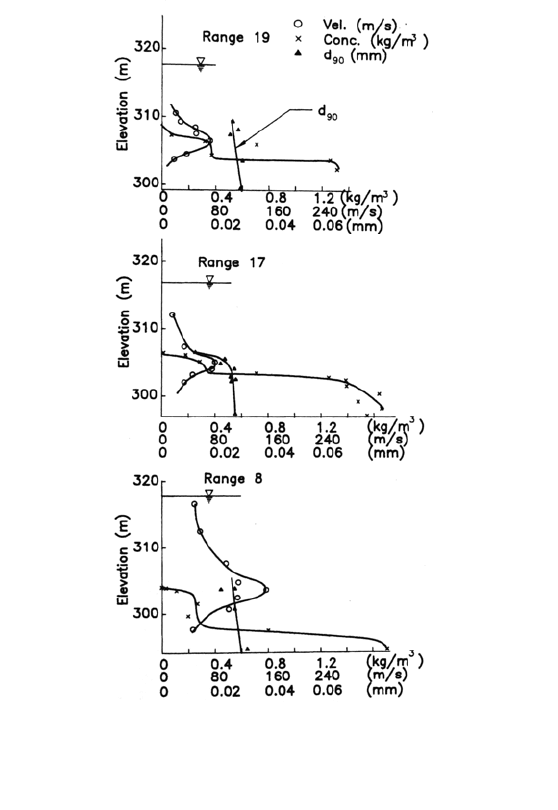
TURBID DENSITY CURRENTS 14.11
FIGURE 14.7 Vertical profiles of velocity, concentration, and d
90
for a
turbidity current flowing over a denser submerged muddy lake in
Sanmenxia Reservoir (Sanmenxia Hydrologic Exp. Sta., 1962).
Longitudinal profiles of the 100-Mm
3
Sautet Reservoir in France (Fig. 14.8a), with
inflow suspended solids concentrations typically in the range of 1 g/L (Nizery & Bonnin,
1953). Even though the turbid density currents had very low concentrations, they still
formed muddy lake deposits before the dam. Horizontal muddy lake deposits are also evident
in longitudinal profiles in Steeg Reservoir on the Oued Fodda in Algeria with inflowing
sediment concentrations on the order of tens of grams per liter (Fig. 14.8b). The absence
of horizontal deposits extending upstream from a dam indicates that turbid density
currents dissipate or deposit most of their load before reaching the dam.
Because coarser sediments settle fastest within the muddy lake, under appropriate
conditions this can create layered muddy lake deposits which are graded coarse to fine,
moving from the bottom to the top of the sediment layer associated with each major
flood.
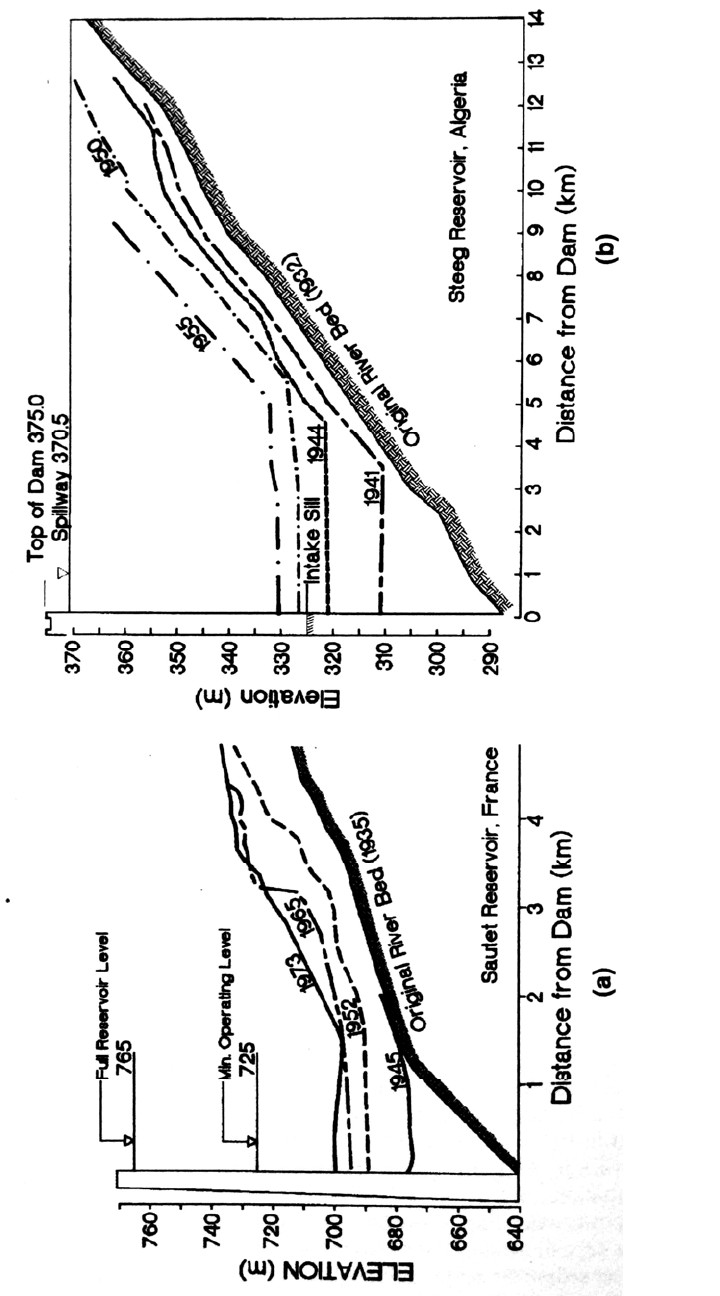
TURBID DENSITY CURRENTS 14.12
FIGURE 14.8 Bottom profile of reservoirs showing the horizontal pattern of sediment accumulation behind the dam characteristic of muddy lake deposits.
(a) Sautet Reservoir, France (Comité Française, 1976). (b) Steeg Reservoir, Oued Fodda, Algeria (Thévenin, 1960).

TURBID DENSITY CURRENTS 14.13
14.3.3 Deposit Effects on Turbidity Currents
Sediment deposition changes reservoir geometry and can alter the ability of turbidity
currents to travel to the dam. Two types of geometric changes reduce the ability of
turbidity currents to travel to the dam, even though inflow conditions are unchanged. First,
thalweg deposition infills the original river channel along which density currents flow,
creating a broad and flat reservoir bottom which causes the turbidity current to flatten
out. This reduces the thickness and increases the width of the current, increasing both
bed and interface friction and also enhancing entrainment of clear water across the
density interface. Second, muddy lake deposits replace the original sloping bottom with
a nearly horizontal surface extending upstream from the dam. This reduction in bottom
slope reduces the gravitational force driving the current forward. Periodic flushing of a
reservoir which maintains a channel along the thalweg is an effective means of
combatting both processes, preserving reservoir geometry conducive to the propagation
of turbid density currents.
Turbidity current movement to the dam can possibly be enhanced by delta deposition
that shortens the effective length of the reservoir and moves the plunge point closer to the
dam, reducing the travel distance for the density current and possibly increasing bed
slope downstream of the delta.
14.4 INDICATORS OF TURBIDITY CURRENTS
Several observable phenomena indicate the presence of turbid density currents in a
reservoir. Turbid water may be discharged from a low-level outlet while surface waters in
the reservoir are clear. Continuous suspended solids monitoring immediately above the
reservoir and at the dam can indicate the presence of turbidity currents and also establish
their travel time to the dam. Bottom water can be continuously discharged through a
low-level outlet and monitored below the dam to observe the arrival of turbid water.
A muddy flow that enters and disappears at the upstream limit of a reservoir, a
phenomenon frequently observed from the air, is an indication of plunging flow. The
plunge line may be observed as a sharp transition between clear and turbid water and by
the accumulation of floating debris. Longitudinal bathymetric profiles revealing nearly
horizontal deposits extending upstream from the dam represent sediment deposits from a
muddy lake, and indicate that significant amounts of sediment are being transported to
the dam by turbidity currents (Fig. 14.8). The presence of turbid density currents or a
submerged muddy lake may also be determined by sampling water quality profiles
during or following runoff events. The presence of density currents of all types may be
measured by sonic or other velocity profiling methods or by monitoring of water quality
parameters such as temperature and dissolved oxygen which distinguish the inflowing
and impounded waters (see Fig. 4.6).
14.5 TURBIDITY CURRENT PROBLEMS IN RESERVOIRS
14.5.1 Blockage of Low-Level Outlets
Turbidity currents can transport appreciable amounts of sediment along the bottom of a
reservoir, causing sediment accumulation in front of the dam which interferes with the

TURBID DENSITY CURRENTS 14.14
operation of low-level outlets. This is not an unusual phenomena in hydropower
reservoirs in mountainous areas.
The 208-m-tall Luzzone Darn in Switzerland, completed in 1963, impounds 36.5 km
2
of the mountainous watershed of the Val Blenio River to create an 87 Mm
3
hydropower reservoir. Although the total amount of sediment deposition in this reservoir
is not large, about 35,000 m
3
/yr, turbid density currents transport sediments into the
immediate vicinity of the dam where they accumulate and interfere with operation of
low-level outlets. By 1983, these deposits had accumulated to a depth of one-third the
height of the low-level power intake, and dredging was performed to remove 17,000 m
3
of deposits near the intake. In 1985, the reservoir was emptied for flushing and about
0.3 Mm
3
of sediment was released.
In 1992 vertical instrumented arrays were deployed to measure density current
movement (Sinniger et al., 1994). Profile 5 was located 250 m upstream of the fsdam and
profile 10 was located 1100 m upstream of the dam, at a point about halfway between
the dam and the upstream pool limit. By examining some of the results summarized in
Table 14.3, it will be seen that only 8 percent of the sediment inflow during the smaller
TABLE 14.3 Summary Measurements of Turbid Density Currents, Luzzone Reservoir
Weight, kg Volume, m
3
Date Profile 5 Profile 10
Profile 5 Profile 10
Aug. 4, 1992 10,267 123,479
9 103
Aug. 29, 1992 29,325 245,971
24 205
Aug. 31, 1992 1,026,852 5,235,728
856 4,363
Source: Sinniger et al. (1994).
August 4 inflow event reached the dam, whereas 20 percent of the upstream flow reached
the dam during the large August 31 event. Turbidity currents repeatedly entered and
traveled along a low-level outlet pipe at the dam, causing sediment to accumulate at the
valve which was located some distance downstream of the entrance to the conduit. On one
occasion the accumulation was so great that it completely blocked the conduit and water
would not flow after the valve was opened, despite high hydrostatic head. This
phenomenon was examined by Boillat and DeCesare (1994) using a physical model
(Fig. 14.9).
14.5.2 Turbidity Currents at a Confluence
Many reservoirs impound river confluences, and sediment-laden discharge from one
tributary can create a turbidity current that affects the other tributary. An extreme
example of this phenomenon occurs at the Liujiaxia hydropower plant, the second largest
in China.
The Liujiaxia Dam across the Yellow River is located 1.6 km below the confluence
with the tributary Taohe River. Sediment-laden discharge from the tributary plunges
beneath the impounded Yellow River and then flows as a turbidity current both
upstream and downstream along the floor of the reservoir, dropping its sediment load and
dissipating. Over the course of many events, this created a localized sand bar that grew
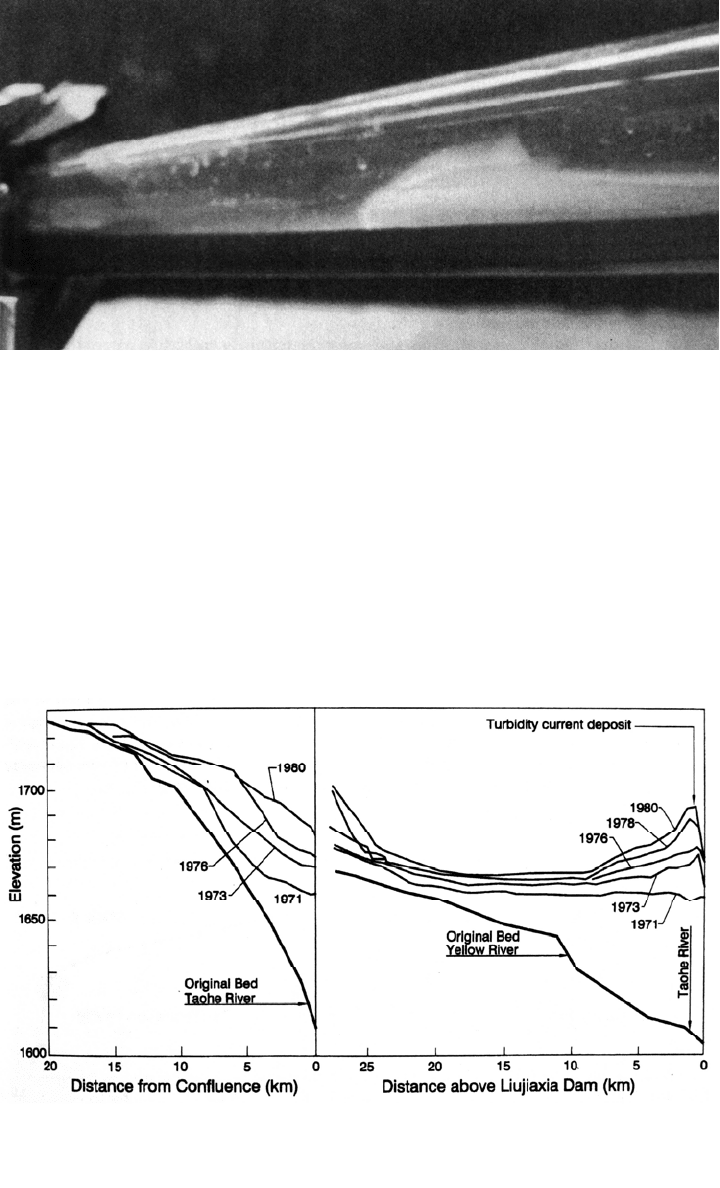
TURBID DENSITY CURRENTS 14.15
until it prevented the diversion of water for power generation at low pool levels.
Sediments in the downstream-traveling turbidity current also entered the power intake
causing abrasion of turbines and gate recesses. Longitudinal profiles of turbidity current
deposition along both the Yellow and Taohe Rivers are shown in Fig. 14.10. During 15
years of impounding operation, serious deposition at the confluence twice caused an
abrupt increase in the elevation of the sand bar. The first event occurred during the 1973
flood season when 14.7 m of deposition occurred. In this case the silt inflow from the
Taohe River was 52.3 × 10
6
tons, twice the average annual discharge, and the outlets at
FIGURE 14.9 Photograph of a turbidity current advancing toward the left along a physical scale
model of a low-level circular conduit at Luzzane Dam, Switzerland. The bulbous-shaped nose at the
front of the advancing current is typical of density underflows (C. DeCesare).
FIGURE 14.10 Change in longitudinal deposit profiles upstream of Liujiaxia Dam on the
Yellow River, caused by localized deposition of sediment from turbidity currents entering
from the tributary Taohe River (Fan, 1991).
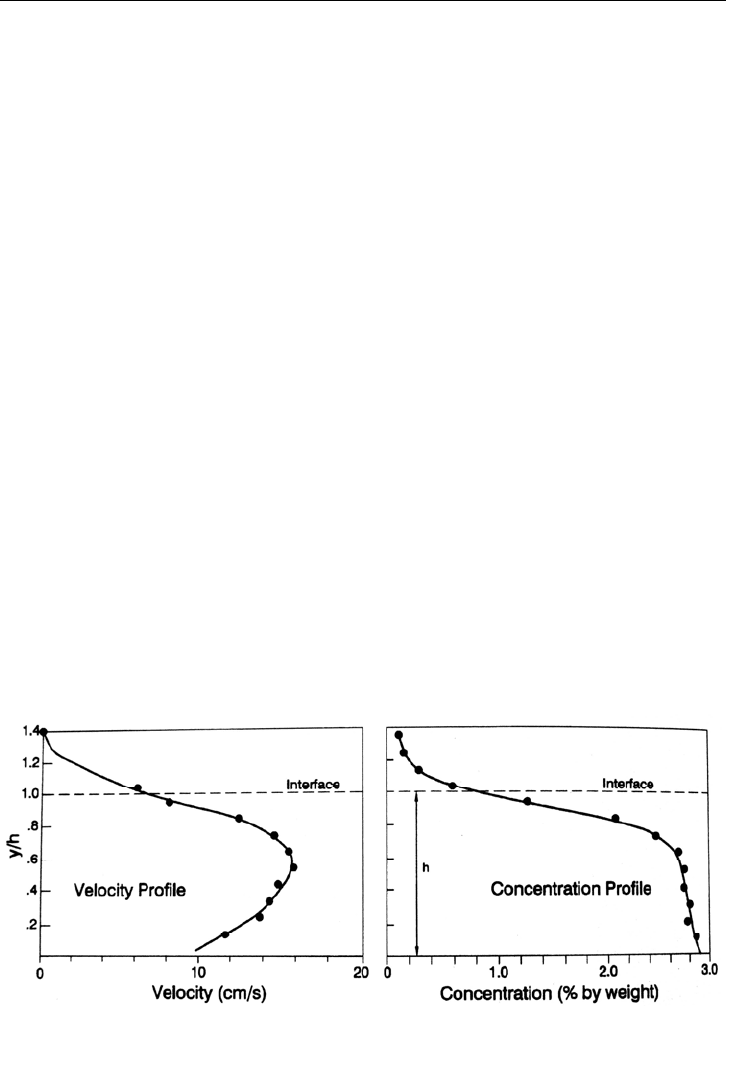
TURBID DENSITY CURRENTS 14.16
the dam were not opened in time to vent the turbidity current as it entered. Deposition
occurred in both the Taohe and Yellow Rivers. The second event occurred during 1978
and 1979; the deposit thickness increased an additional 15.6 m during this period.
14.6 VERTICAL STRUCTURE OF TURBIDITY CURRENTS
In a turbidity current the density interface (which is also the turbidity interface) will
approximately coincide with the velocity interface. However, when density differences
are imparted mainly by temperature, the turbidity may become concentrated in the lower
part of the flow or may largely settle out even though the temperature-driven current
continues flowing. Atypical conditions may also occur as the current is fading away and
depositing the remaining sediment load.
Vertical profiles of concentration and velocity within a turbidity current are
illustrated in Fig. 14.11. The vertical structure will vary as a function of hydraulic
parameters including roughness and Froude number. In a turbidity current, a significant
vertical variation in sediment concentration will normally be observed only in the vicinity
of the plunge point, where the current is in the process of rapidly depositing its coarse
fraction. After the coarser particles have been largely deposited and only finer-grained
sediments remain in suspension, the vertical concentration profile is usually quite uniform
in terms of both grain size and concentration as observed in flume tests (Fan et al., 1959;
Michon et al., 1955) and also in reservoir data. An inflection point on the concentration
profile occurs near the interface, and above the interface the concentration is always very
low. Figure 14.12 illustrates vertical profiles of velocity and turbidity measured over
the course of 5 days in Sanmenxia Reservoir showing the growth and dissipation of a
turbidity current. During this event, the water in the Yellow River was also moving
downstream along the reservoir, resulting in forward motion in overlying water as well as
in the faster-moving turbidity current. Several features of a turbidity current event are
illustrated by these data: (1) the turbidity interface is sharp over the duration of the
event, (2) the zone of forward velocity is always within the turbid water zone except at
the end of the event as flow is dissipating, and (3) the unsteady behavior of the turbidity
current over the duration of the event. An appreciable concentration of fine sediment may
remain in suspension even after the current has ceased moving.
FIGURE 14.11 Vertical profiles of velocity and concentration within a turbidity current (Ashida
and Egashira, 1975)
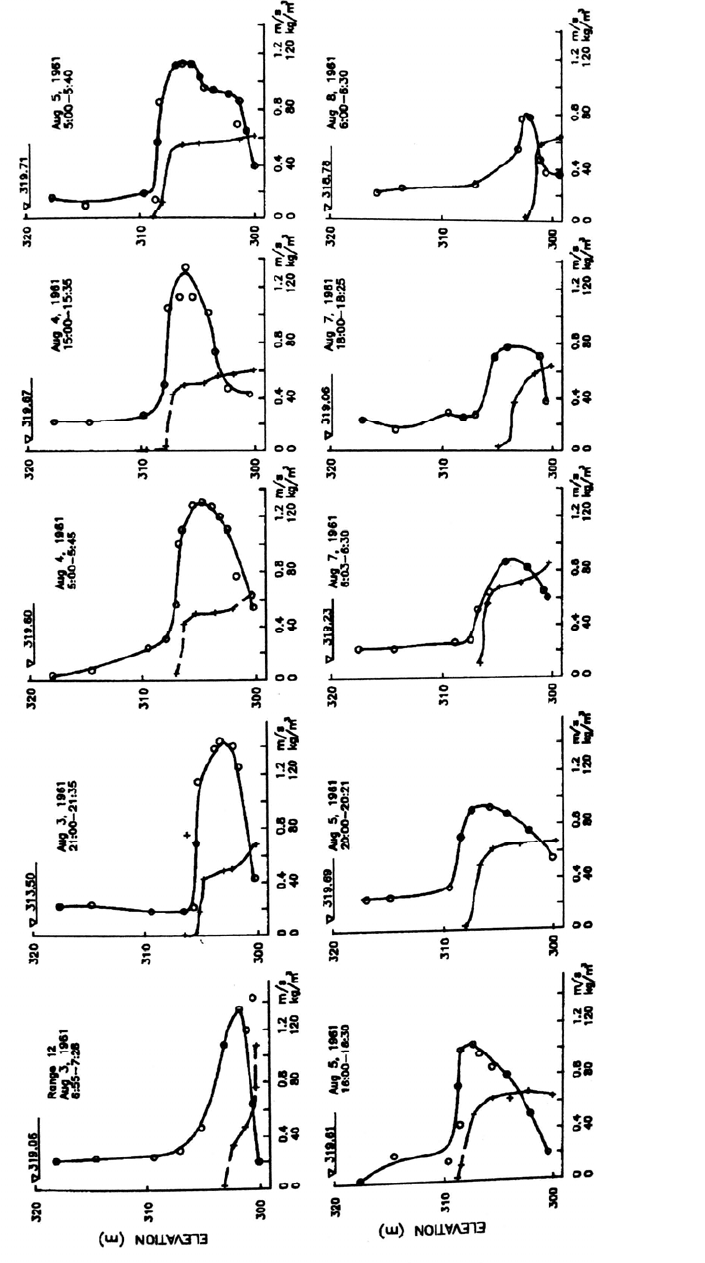
TURBID DENSITY CURRENTS 14.17
FIGURE 14.12 Vertical profiles of concentration (crosses) and velocity (circles) for a 5-day turbidity current event at range 12 in Sanmenxia Reservoir, showing
the growth and fading away of the current (Fan, 1991).

TURBID DENSITY CURRENTS 14.18
14.7 VENTING OF TURBIDITY CURRENTS
14.7.1 Overview
Turbidity currents can be vented from reservoirs by opening a low-level outlet at the
dam, and at some reservoirs it has been possible to release more than half the total
sediment load in an individual flood by venting the turbidity current. Successful venting
depends on properly located low-level outlets, which are opened in time to release the
current using a discharge rate that matches the turbidity current inflow. However, it will
not be possible to vent turbidity currents in many reservoirs, and the efficiency of
releasing turbidity currents can decline over time as deposition which fills the
submerged channel changes the reservoir bathymetry and impedes propagation of the
turbidity current.
Turbidity currents may also be vented for environmental reasons. For example, at the
Lost Creek reservoir in Oregon it was desired to release turbid water from the pool during
large inflowing storms, flushing turbid water along the river and to the ocean over a short
period of time, rather than to trap turbid water in the reservoir where it would be released
more gradually over a longer period of time. In this stream it was considered more
desirable to have a short high-turbidity period followed by normal low-turbidity flows,
as opposed to a prolonged period of elevated turbidity. The turbidity conduit for this
reservoir is shown in Fig. 4.7.
14.7.2 Venting Efficiency
A turbidity current will flow only as long as there is a continued input of turbid water at
the upstream end of the reservoir, and it will stop as soon as the inflow ends. Thus, when
inflow ends, the portion of the current spread out along the length of the reservoir will
stall and the turbidity will settle in place. This portion of the current cannot be vented. As
a rough approximation, the maximum amount of an inflowing turbidity current that can
be vented will equal the total inflow volume less the volume of the density current retained
along the length of the reservoir.
Based on this conceptual model, Fig. 14.13 presents the relationship between
releasing efficiency W
o
/W
i
and reservoir length L, giving also the Q
o
/Q
i
value for each
venting event, where W
i
and W
o
represent, respectively, the inflowing and outflowing
(vented) turbidity current, and Q
o
and Q
i
represent the average flow rates for inflow and
turbidity release. Venting efficiency tends to increase as the reservoir length decreases
and as the Q
o
/Q
i
ratio increases. In practice, the venting efficiency is heavily influenced
by the timing of gate openings and their arrangement at the dam. The effect of timing of
gate operations on venting efficiency is discussed in the Heisonglin case study (see Table
25.4). Venting efficiency exceeding 100 percent has occasionally been reported, but is
usually related to either: (1) entrainment of additional sediment by scour of deposits
between the upstream monitoring station and the plunge point and (2) release of
unconsolidated sediments within a muddy lake created by a prior event.
14.7.3 Timing and Duration of Releases
To efficiently vent a turbidity current, it must be known when the current arrives at the
dam and when it ends, to time the opening and closing of gates. Turbidity current motion
may be measured in situ by instrument arrays, or it may be estimated from inflow
conditions and previous measurements. The in situ measurement of turbidity currents can
today be conducted without great expense by deployment of reporting sensors, such as
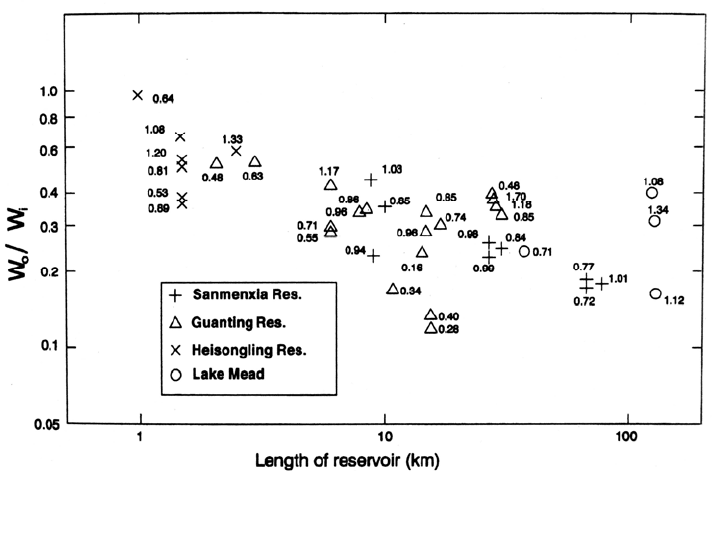
TURBID DENSITY CURRENTS 14.19
FIGURE 14.13 Release efficiency for turbidity current venting events as a function o
f
reservoir length and discharge ratio Q
o
/Q
i
(shown as numerical values).
tu
rbidimeters. Turbidity measurements at an inflow station plus one or more reservoir
stations can be used to monitor turbidity current formation and forward motion.
The velocity of a turbidity current within a particular reservoir increases as a function
of the inflowing the flood discharge. Figure 14.14 illustrates data collected at
Guanting Reservoir, showing the relationship between turbidity current propagation time
and discharge. Data are shown for different lengths within the reservoir corresponding to
different pool elevations.
The duration T
o
of the release is proportional to the duration T
i
of the inflow period for a
specific reservoir length. Analysis of data from Guanting Reservoir yielded the relationship
presented in Fig. 14.15. This relationship indicates that for short travel distances the discharge
period may actually be longer than the inflow period. However, as travel distance increases,
discharge can be sustained over a progressively shorter fraction of inflow period (the T
o
/T
i
ratio decreases). As pool length increases, a larger portion of the inflowing current remains
trapped in the reservoir when inflow declines and forward motion stalls.
These two figures were developed to predict the timing and duration of turbidity
current release at Guanting Reservoir, and similar relationships may be developed for
other sites. These relationships can change with time as the bathymetry changes because
of sedimentation.
14.7.4 Discharge
The greatest amount of turbidity can be released when the discharge capacity of the outlet
approximately matches the flow rate of the turbidity current reaching the dam.
However, it is also possible to release a concentrated flow from the muddy lake that
accumulates before the dam. The release of a concentrated turbidity flow through a
small-diameter low-level outlet at Steeg Dam in Algeria is shown in Fig. 14.16.
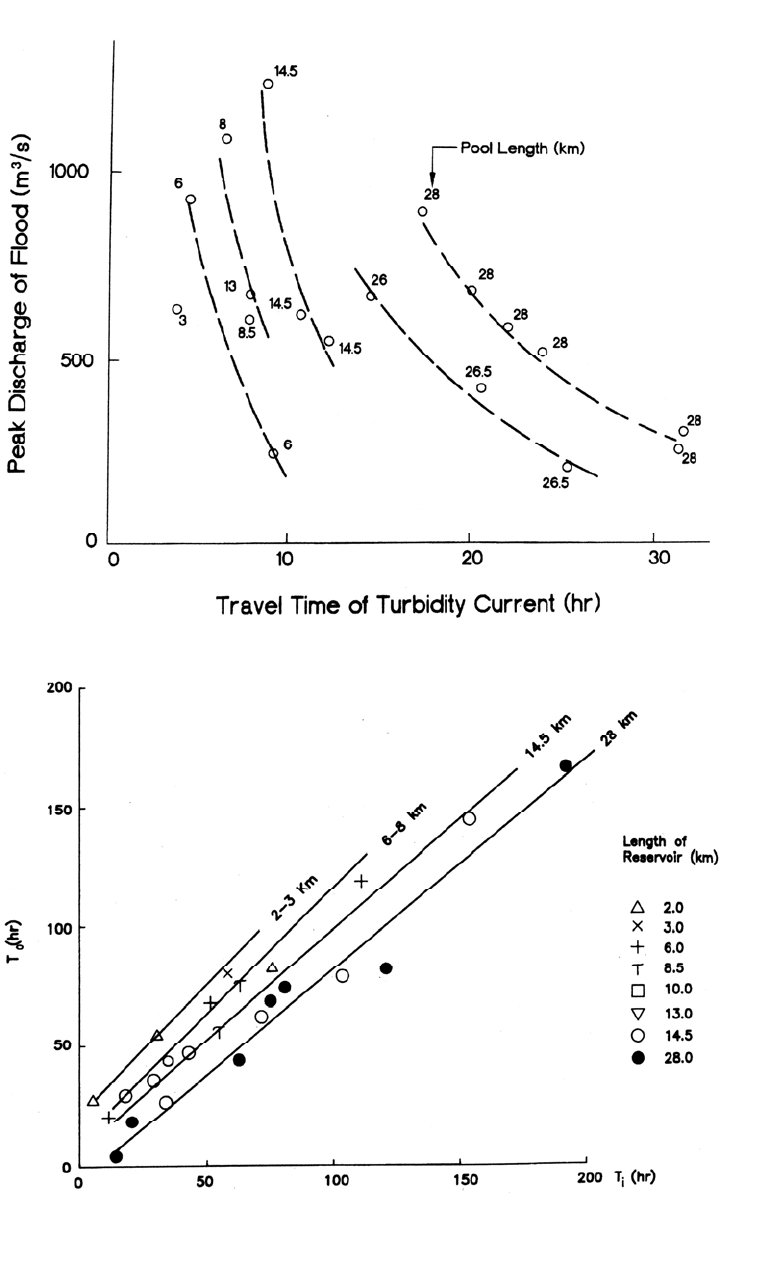
TURBID DENSITY CURRENTS 14.20
FIGURE 14.14 Variation of turbidity current travel time with peak flood discharge an
d
pool length, Guanting Reservior (Fan and Jiao,1958)
FIGURE 14.15 Relationship between duration of turbidity current release (T
o
) and inflow period (T) as
a function of pool length, as measured in Guanting Reservoir at various pool levels (Fan and Jiao,
1958).
